 Marc Armand Rousso, Entrepreneur, philanthropist, chess aficionado, made his fortune in the US as a trader of stamps. He is famed to have bought the Treskilling Yellow, one of the most valuable stamps of all time. went on to found numerous enterprises. One was the X3D Display, hardware and software that allow radically lifelike 3D images that appeared to jump off the (CRT) screen and into the room, using both glasses-based and glasses-free 3D technologies.
Marc Armand Rousso, Entrepreneur, philanthropist, chess aficionado, made his fortune in the US as a trader of stamps. He is famed to have bought the Treskilling Yellow, one of the most valuable stamps of all time. went on to found numerous enterprises. One was the X3D Display, hardware and software that allow radically lifelike 3D images that appeared to jump off the (CRT) screen and into the room, using both glasses-based and glasses-free 3D technologies.
To promote this technology Rousso decided to stage a chess match in New York – played without chessboard and pieces. For this he contacted ChessBase, asking us to use his technology to create virtual 3D chess software – twenty years ago!
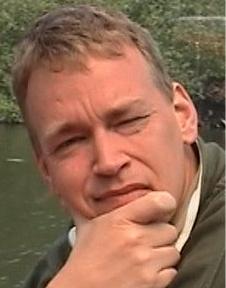 Fortunately we had a new programmer in our team, someone who was keenly interested in new technologies. Jeroen van den Belt set to work creating a version of Fritz that fulfilled Armand's needs. X3D Fritz could display a vivid, animated chess board, and accepted voice commands for the moves.
Fortunately we had a new programmer in our team, someone who was keenly interested in new technologies. Jeroen van den Belt set to work creating a version of Fritz that fulfilled Armand's needs. X3D Fritz could display a vivid, animated chess board, and accepted voice commands for the moves.
In this and other Rousso-driven enterprises I was in New York a number of times with Jeroen – and quite an adventure it was. Armand had a wonderful flat in Manhattan, and gladly let us use it during our stays.

The view from the living room of Armand's flat, over the Hudson – spectacular!

The view from my bedroom, which directly overlooked Ground Zero, where the World Trade Center had stood and come crashing down two years earlier
So who would be invited to play against X3D Fritz? For Armand things were clear: it had to be Garry Kasparov. And he had to play without board or pieces.
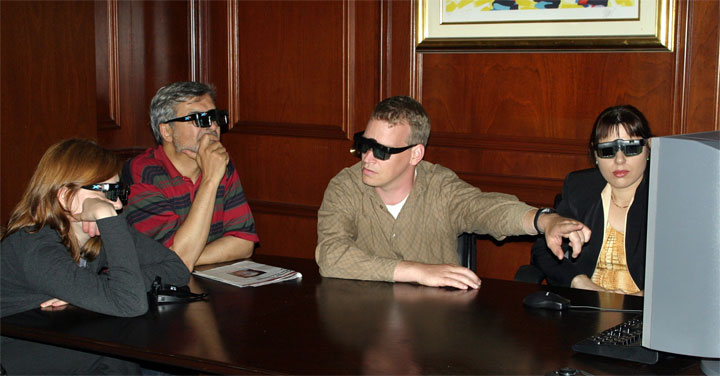
We (Frederic and Jeroen) tested the technology with a number of chess professionals...
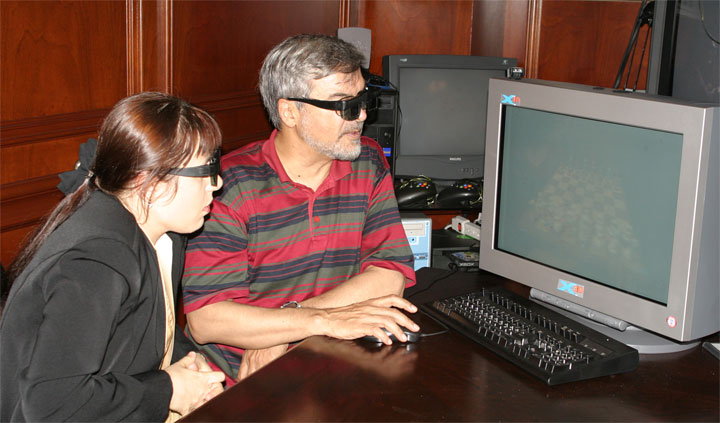 Susan Polgar, who helped us with our preparations, found the technology perfectly acceptable
Susan Polgar, who helped us with our preparations, found the technology perfectly acceptable
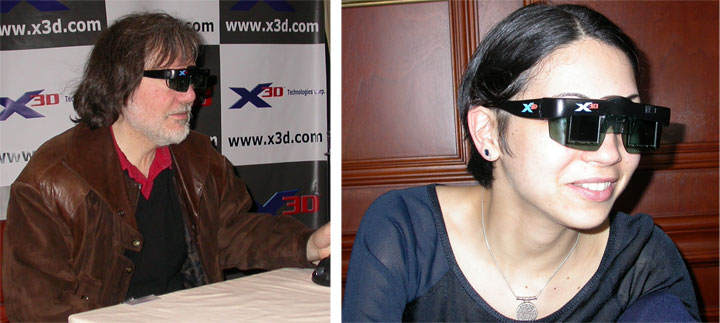
Testing the X3D technology: GM Ian Rogers and US Women's Champion Anna Hahn
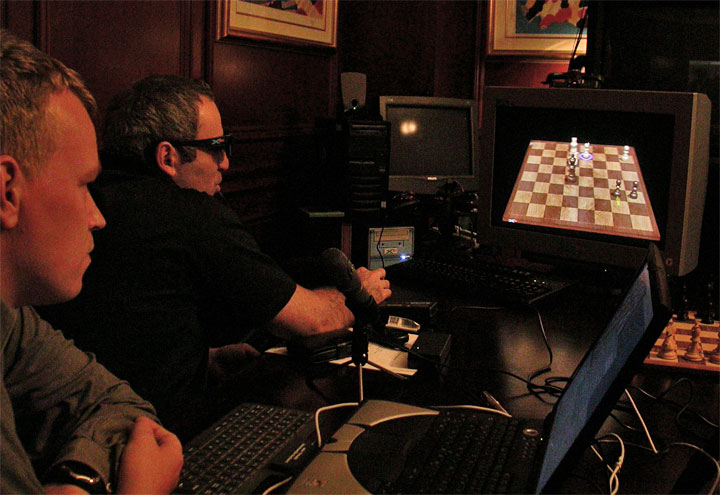
Garry, to my surprise, quite spontaneously agreed to play on Jeroen's virtual chessboard, wearing glasses and dictating his moves. He loves new technology!
So the match was arranged for November 2003. For us it started with another adventure. It's a story I need to tell.
The break-in adventure
Our flight was leaving at 7:15 a.m. from Hamburg. Mathias Feist, the Fritz programmer was was travelling with me. We arrived at the ChessBase office, which is just 15 minutes from the airport, shortly before six in the morning. Mathias needed to pick up his notebook, which contained all the main preparation for the match, and some important installation CDs from the office, where everything had been prepared and placed on the desk for him to pick up.
We arrived at the large office building block in which ChessBase is located only to find it surrounded by police cars. We were stopped, and a well-armed police officer asked us exactly what we wanted. When we told him we intended to go up to our offices they said it was completely out of question. There were burglars somewhere in the building complex, probably armed and dangerous, and they were waiting for additional swat teams and dogs before entering the location.
That was quite a dilemma. We did not have time to wait, and explained the gravity of the situation. After a while the officers agreed to allow us up the staircase to our office, where we promised we would quickly nip in to extract the notebook and the CDs. "It will take us just one minute," I said, "and then we will be out of here."
The police built a small swat team to accompany us upstairs. When we arrived at our storey this is what we found:
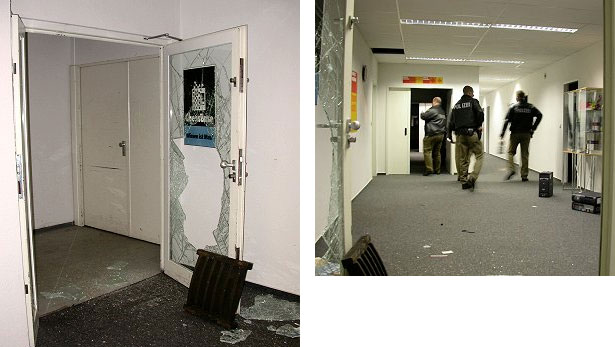
Yep, the burglars had broken into our office, we were the object of their evil intentions. Note that our doors are made of heavily reinforced glass. The way they had broken in was by heaving a cast-iron manhole cover into it.
The three-man swat team asked us to stand back and entered the facilities. Everything was thrashed, computers had been vandalised, draws opened, lockboxes destroyed. With guns drawn they secured the front half of the office, allowing us to enter the room where the notebook and the CDs had been deposited for us. But of course there was no notebook in sight. Only the Tablebase CDs were untouched. These we grabbed and made a dash for the airport. We caught our plane with minutes to spare. Mathias spent the first leg of the flight shaking his head. Somewhere over the Atlantic, after we had taken a glass of excellent Lufthansa red wine, our hands stopped shaking, and we could start thinking about how to work around the damage that had been done to our preparations for the match (the other staff members in Hamburg could figure out how to repair the damage done to our facilities).
The match
Before the match Kasparov vs X3D Fritz began statistician Jeff Sonas traced the progress of top programs compared to the strongest player alive. Computers were getting there...

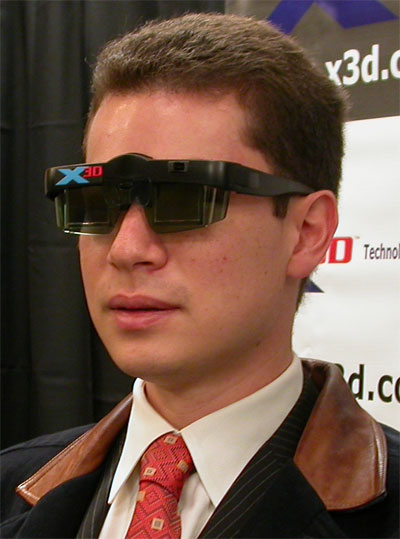 At the time GM Joel Lautier summarized the match for us, explaining two key positions:
At the time GM Joel Lautier summarized the match for us, explaining two key positions:
The first game was a messy affair, with Kasparov outplaying the computer in the opening stage with a typical pawn sacrifice, but failing to convert his advantage due to the computer's clockwork defence.
The second game was a heartbreaker for Garry, as he had skilfully outmanoeuvred X3D Fritz yet again, only to blunder the game away in one move. As we shall see, there was an uncanny feeling that the computer had actually sensed the human champion could err exactly the way he did, for the tactical motif that caught Kasparov off-guard was very cunningly brought about by the machine.
The third game was every grandmaster's dream, the computer entered an unfortunate opening scheme that left the position completely locked up. Unable to devise a long-term plan, the computer shuffled its pieces around aimlessly, while Kasparov was patiently amassing his pieces to deliver the winning blow. In a position it still assessed as inferior but not lost for itself, the computer was made to resign by an embarrassed team of programmers.
The final game was a bit of an anti-climax, with Kasparov playing very prudently to secure a draw in the game and in the match overall.
Four games is too short a distance to gauge the players' relative strengths when they are so evenly matched. As a matter of fact, this encounter did not shed any new light on computer chess. The machine won and lost in the way we were accustomed to and Kasparov is right to say that he was dominating in most of the games. However, his extreme nervousness in facing machines has played tricks on him once more, and he wasn't able to capitalize on his better positions.
Here are games four, annotated for us by Mig Greengard, followed by game one, unannotated:
Media bomb
The match between Kasparov and X3D Fritz was an unprecedented success, generating more media coverage than any chess game in history. At one stage there were 46,000 articles listed in Google, the event was carried live on the Internet to literally millions of viewers, and it was shown in 17½ hours of live broadcast on America's biggest cable TV sports channel, ESPN.
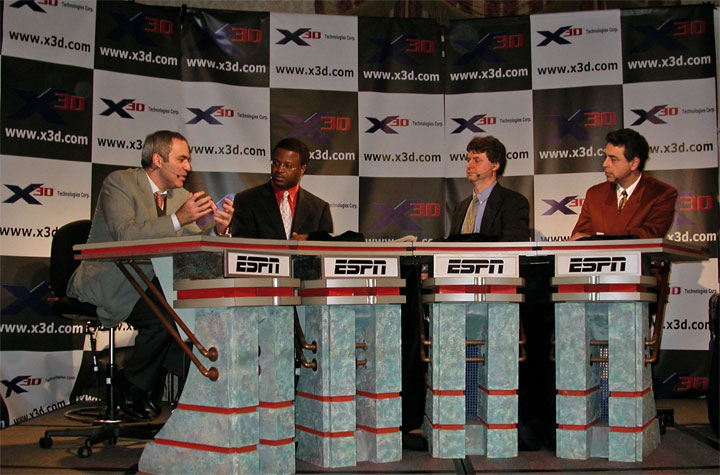
Postgame wrap up, with Kasparov, Maurice Ashley, Paul Hoffman and Yasser Seirawan

Live satellite broadcast trucks outside the venue, the posh salons of the New York Athletic Club
Links
All Fritz history articles
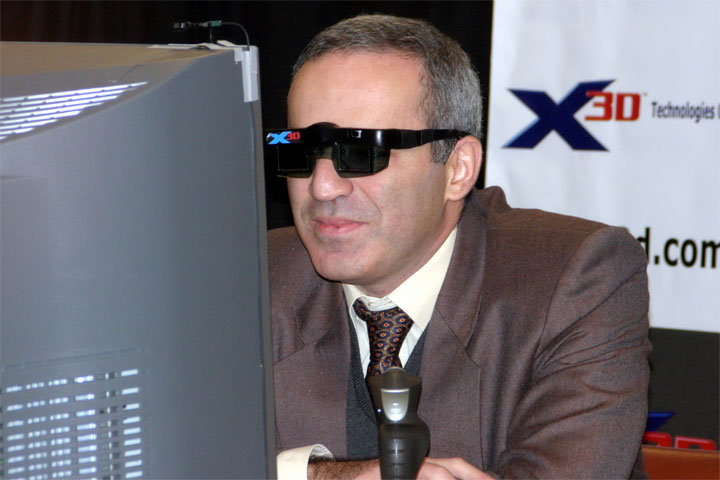


















 Fortunately we had a new programmer in our team, someone who was keenly interested in new technologies. Jeroen van den Belt set to work creating a version of Fritz that fulfilled Armand's needs. X3D Fritz could display a vivid, animated chess board, and accepted voice commands for the moves.
Fortunately we had a new programmer in our team, someone who was keenly interested in new technologies. Jeroen van den Belt set to work creating a version of Fritz that fulfilled Armand's needs. X3D Fritz could display a vivid, animated chess board, and accepted voice commands for the moves.







 At the time
At the time 






